Introduction
Braised pig’s head meat, a culinary delight enjoyed across various regions in China and beyond, is a dish that combines rich flavors, tender texture, and a deep, satisfying aroma. While it may seem intimidating to prepare at first, with the right techniques and ingredients, you can create a mouthwatering braised pig’s head meat that will leave your taste buds yearning for more. This comprehensive guide will walk you through the entire process, from selecting the perfect pig’s head to achieving that perfect braised finish. By the end, you’ll be equipped with the knowledge and skills to make a braised pig’s head meat that is not only delicious but also a feast for the senses.
Section 1: Choosing the Right Pig’s Head
The foundation of any great braised dish starts with selecting high-quality ingredients. When it comes to pig’s head meat, there are a few key factors to consider:
1 Freshness
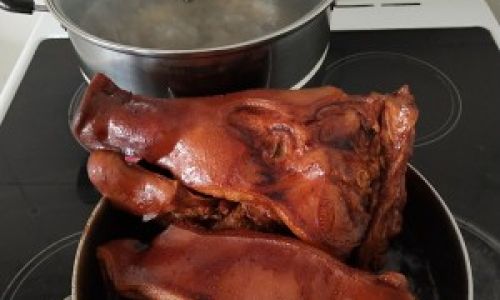
Always opt for a freshly slaughtered pig’s head. Freshness is crucial as it ensures the meat retains its natural juices and flavors, leading to a more tender and flavorful final dish. If purchasing from a butcher or market, ask when the pig’s head was slaughtered and inspect it for any signs of spoilage, such as an unpleasant odor or discoloration.
2 Size and Weight
The size and weight of the pig’s head can vary, and your choice will depend on how many servings you need. Generally, a medium-sized pig’s head weighs between 2 to 3 kilograms and is ideal for feeding a small gathering or family meal. Larger pig’s heads are suitable for larger gatherings or if you plan to have leftovers.
3 Fat Content
The fat content of the pig’s head can affect the final texture and flavor of your braised dish. While some fat is necessary for flavor and moisture retention, too much can make the dish greasy. Choose a pig’s head with a balanced fat-to-meat ratio, preferably one where the fat is evenly distributed.
Section 2: Preparation and Cleaning
Once you’ve selected your pig’s head, it’s time to prepare and clean it properly. This step is crucial as it removes impurities and ensures a cleaner, more pleasant-tasting final dish.
1 Scalding
Begin by scalding the pig’s head in boiling water. This helps to loosen any dirt, hair, or skin residue. Place the pig’s head in a large pot of boiling water and let it simmer for about 5 minutes. Remove it using tongs and let it cool slightly.
2 Hair Removal
Use a sharp knife or a pair of scissors to carefully remove any remaining hair from the pig’s head. This can be a tedious process, but it’s essential for a presentable and enjoyable dish.
3 Skinning and Trimming
If desired, you can remove the skin from the pig’s head. Some recipes call for skin-on for added texture and flavor, while others prefer it skinless. Use a sharp knife to carefully peel off the skin, taking care not to cut into the meat. Trim away any excess fat, sinew, or bones that you don’t want in your final dish.
4 Rinsing
Thoroughly rinse the pig’s head under cold running water to remove any remaining dirt, hair, or debris. Pat it dry with paper towels.
Section 3: Seasoning and Marinating
Seasoning and marinating the pig’s head before braising helps to infuse it with flavor and tenderize the meat.
1 Basic Seasoning
Start with basic seasoning such as salt, pepper, and garlic. Rub the seasoning evenly over the entire surface of the pig’s head, ensuring that all parts are well-coated.
2 Marinade
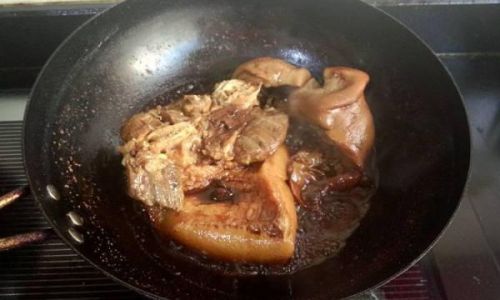
For added depth of flavor, create a marinade using soy sauce, rice wine (or dry sherry), ginger, scallions, and star anise. Place the seasoned pig’s head in a large bowl or container, pour the marinade over it, and let it sit for at least 2 hours, preferably overnight in the refrigerator for maximum flavor penetration.
Section 4: Preparing the Braising Liquid
The braising liquid is what will cook the pig’s head slowly, allowing all the flavors to meld together and the meat to become tender.
1 Ingredients
Gather your braising liquid ingredients, which typically include:
- Soy sauce
- Dark soy sauce (for color)
- Rock sugar or granulated sugar
- Ginger slices
- Garlic cloves
- Scallions
- Star anise
- Chinese five-spice powder
- Shaoxing wine or dry sherry
- Chicken or pork broth
- Water
2 Making the Braising Liquid
In a large pot, combine all the braising liquid ingredients except for the water. Bring the mixture to a simmer, stirring occasionally to dissolve the sugar. Once the sugar is fully dissolved, add enough water to cover the pig’s head by about 2 inches. Adjust the seasoning with additional soy sauce or sugar if needed.
Section 5: The Braising Process
Now, it’s time to braise the pig’s head. This slow-cooking method is what transforms tough, sinewy meat into a tender, flavorful delight.
1 Bringing to a Simmer
Carefully place the marinated pig’s head into the pot of braising liquid. Ensure it is fully submerged. Bring the liquid to a gentle simmer over medium-low heat. Avoid boiling vigorously as this can cause the meat to toughen.
2 Skimming the Fat
As the braising liquid comes to a simmer, skim off any foam or impurities that rise to the surface using a ladle or spoon. This step helps to clarify the braising liquid and ensures a cleaner final flavor.
3 Covering and Simmering
Once the foam has been skimmed, cover the pot with a tight-fitting lid and let the pig’s head simmer gently. The cooking time can vary depending on the size of the pig’s head and your preferred level of tenderness, but it typically ranges from 2 to 4 hours.
4 Checking for Tenderness
Periodically check the pig’s head for tenderness using a fork or chopsticks. The meat should be easily pierced and fall apart when prodded. If the meat is still tough, continue simmering and check again after another 30 minutes to an hour.
Section 6: Finishing Touches
Once the pig’s head is tender and flavorful, it’s time to finish the dish.
1 Removing from the Pot
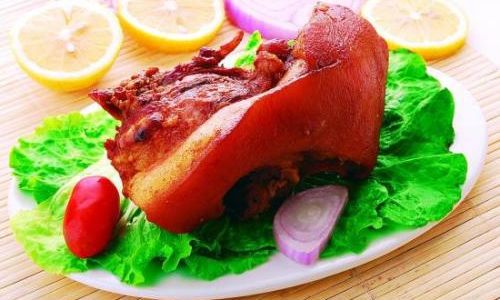
Carefully remove the pig’s head from the braising liquid using tongs or a slotted spoon. Place it on a plate or cutting board to cool slightly.
2 Reducing the Sauce
While the pig’s head is cooling, return the braising liquid to a simmer and let it reduce slightly to concentrate the flavors. This step is optional but highly recommended for a richer, more flavorful sauce.
3 Separating the Meat
Once the pig’s head has cooled enough to handle, use a sharp knife or your fingers to separate the meat from the bones and any remaining sinew. Discard the bones and sinew, and shred or chop the meat into bite-sized pieces.
4 Combining with Sauce
Place the shredded meat back into the reduced braising liquid, stirring to coat each piece evenly with the sauce. Let it simmer for another 5-10 minutes to allow the flavors to meld together.
Section 7: Serving and Enjoying
Your braised pig’s head meat is now ready to serve. Here are a few serving suggestions to elevate your dish:
1 Garnishes
Garnish the braised pig’s head meat with chopped scallions, sesame seeds, or chopped cilantro for a burst of fresh flavor and color.
2 Accompaniments
Serve the braised pig’s head meat with steamed rice, noodles, or pickled vegetables to balance the rich flavors of the meat.
3 Presentation
For a presentable dish, transfer the braised pig’s head meat to a serving platter, spooning some of the reduced braising liquid over the top. Garnish as desired and serve immediately.
Conclusion
Making delicious braised pig’s head meat is a rewarding culinary endeavor that requires patience, attention to detail, and a love for flavorful, tender dishes. By following this comprehensive guide, from selecting the right pig’s head to mastering the braising process, you’ll be able to create a dish that is not only a culinary delight but also a testament to your culinary skills. Enjoy the process and savor every bite of your homemade braised pig’s head meat!
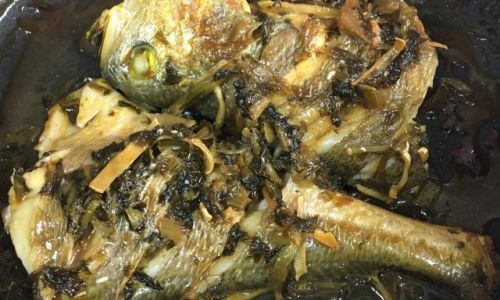
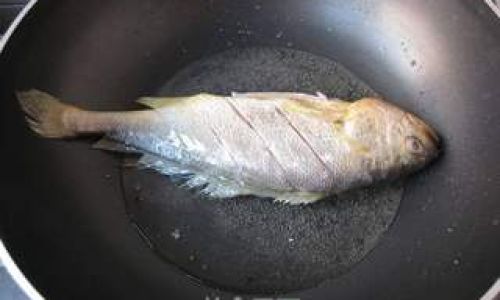
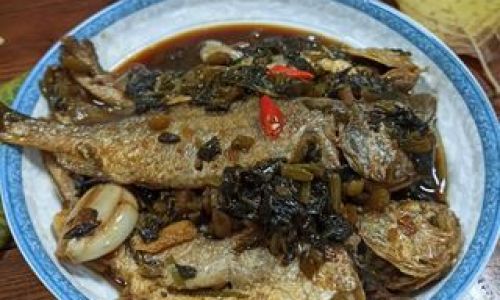
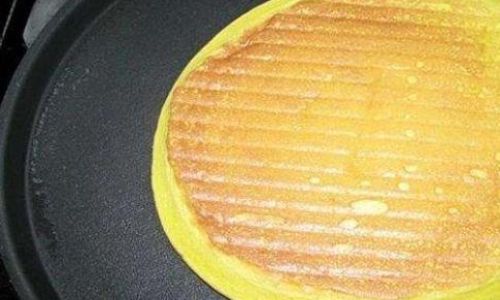
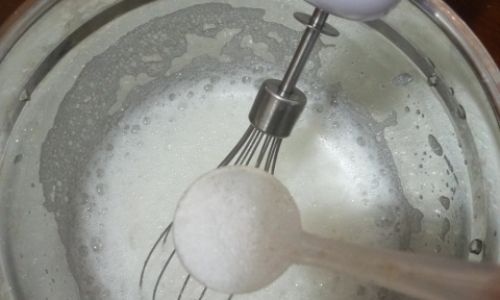
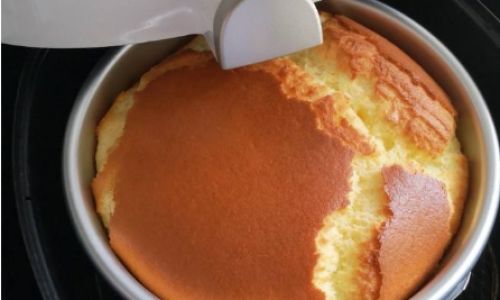
0 comments